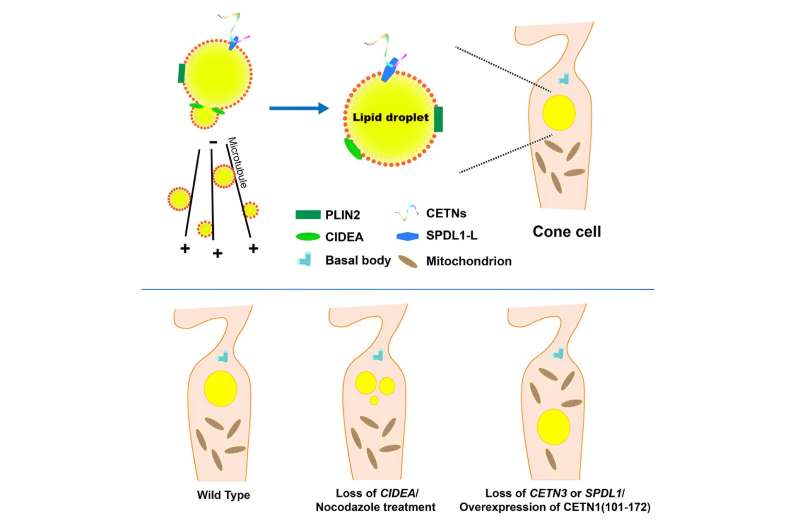This article has been reviewed according to Science X's editorial process and policies. Editors have highlighted the following attributes while ensuring the content's credibility:
fact-checked
peer-reviewed publication
trusted source
proofread
Study provides new insights into lipid droplet dynamics

In a study published in Developmental Cell, researchers led by Prof. Huang Xun from the Institute of Genetics and Developmental Biology of the Chinese Academy of Sciences demonstrated the role of lipid droplet-localized CETN-SPDL1-L in the regulation of cone cell lipid droplet localization, which is important for cone cell light sensitivity.
Lipid droplets are conserved from bacteria to mammals. As evolutionarily conserved organelles, lipid droplets perform many functions. Dysregulation of lipid droplet dynamics causes many metabolic diseases, such as obesity, diabetes, and fatty liver. Most eukaryotic cells contain lipid droplets. However, in the nervous system, lipid droplets are usually found in glia, but not in neurons. Neuronal lipid droplets are found in certain disease conditions and have been speculated to protect neurons from neurodegeneration.
Interestingly, a single lipid droplet is found in the apical region of chicken cone cells, which are a type of neuron. It was previously unclear how the lipid droplet forms, how its location is determined, and what its function is in cone cells.
In this study, the researchers established in vitro and ex vivo culture systems to explore the regulation of lipid droplet dynamics in chicken cone cells. To understand how the individual lipid droplet forms, the team carried out lipidomic analysis, genetic manipulation, and pharmacological manipulation. They found that CIDEA, a previously characterized protein important for lipid droplet fusion, and microtubules regulate the number of lipid droplets in cone cells.
To explore the underlying mechanism of the apical location of the lipid droplets in cone cells, the researchers further performed proteomic analysis.
Intriguingly, they found that centrin proteins, which normally localize to centrioles, target the cone cell lipid droplet with the help of SPDL1-L, a previously uncharacterized isoform of the kinetochore-associated coiled-coil protein SPDL1. CETN-SPDL1-L ensures the apical localization of the cone cell lipid droplet.
To investigate the effect of lipid droplet dynamic changes on cone cell function, the researchers used the finite-difference time-domain (FDTD) method to calculate the electromagnetic field distribution and simulate light propagation in cone cells. The results suggested that both the correct location and correct number of lipid droplets in cone cells are important for light sensitivity.
This work provides new insights into the previously unappreciated relationship between the centrosome protein and lipid droplet localization. In addition, the researchers also established a new model that will enable future studies in the field of lipid droplets.
More information: Huimin Pan et al, Centrins control chicken cone cell lipid droplet dynamics through lipid-droplet-localized SPDL1, Developmental Cell (2023). DOI: 10.1016/j.devcel.2023.08.012
Journal information: Developmental Cell
Provided by Chinese Academy of Sciences





















